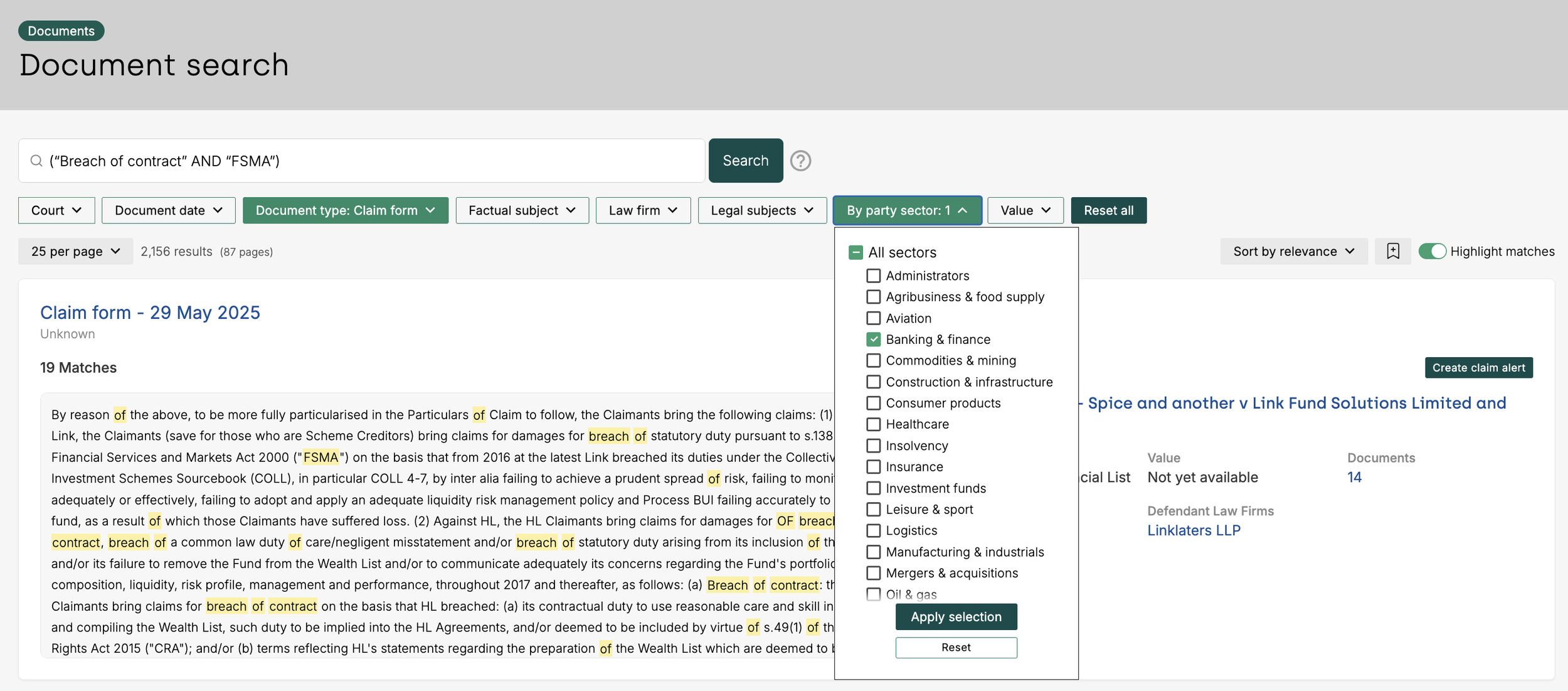Document search tool
For the first time, High Court documents are fully searchable with our Solomonic Document Search tool. This tool provides you with searchable access to the content of the most comprehensive and reliable set of over 31,000 High Court dispute document including claim forms, particulars, orders and defence filings.
On this page, you will find out more information on:
We strongly recommend reading this full page before diving into the tool.
How to use the tool and understanding Boolean search
Our document search supports flexible ways of finding exactly what you’re looking for. You can use simple text search or more advanced search operators to refine your results. You can also find these instructions within the platform - just hover over the ( ? ) icon and these directions will appear on a panel.
To access the tool, click on the menu tab found on the top left-hand corner of your screen. Select ‘Document Search Tool’ from the dropdown under 'Data’.
Search
You can either:
Use basic search - just type the words you’re looking for
For example: breach of contract
This will return documents containing any of the words breach, of, or contract. Boosting results with multiple matches and especially those containing the exact phrase.
Use phrase search - use quotation marks to search for an exact phrase
For example: “breach of contract”
This will only return documents containing that exact phrase.
You must use the search bar that is specific to the document search tool. The search bar on the home page and across the top of the page will not produce document search results.
Boolean operators (AND/OR)
OR broadens your search
For example: breach OR contract
Returns documents with either breach or contract (or both).
AND narrows your search
For example: breach AND contract
Returns only documents that contain both terms.
Grouping
You can use parentheses ( ) to control how terms are combined.
For example: (breach OR contract) AND negligence
This returns documents that contain negligence as well as either breach or contract.
Filters
You can apply additional filters to your search.
For example: if you only wanted to see claim forms that included terms “breach” AND “FSMA”, within the banking & finance sector.
See image below.
Results returned and relevance
Understand how the system returns results and what you’re able to do with those results.
Relevance
Search results are ordered using BM25 relevance scoring, a widely used algorithm in information retrieval. BM25 evaluates how well each document matches the search term by considering:
Term frequency: documents where the search terms appear more often are considered more relevant.
Term rarity: terms that occur less frequently across all of the documents are weighted more strongly than common terms.
Document length: longer documents are normalised so they do not rank higher simply due to their size,.
The final relevance score reflects the balance of these factors, ensuring that results most closely aligned with the search terms appear first.
What can you do with results?
Once you’ve entered your search, the system will display the relevant results. You can scroll through the platform to view the different claim documents, each accompanied by a short snippet of the document. If a snippet exceeds the space in the display box, move your mouse into the box to scroll within it.
Quick actions:
Create an alert for the claim by clicking on the green ‘Create claim alert’ button.
View the landing page for the claim by clicking on the claim number on the right-hand side.
View all other details pertaining to the claim by clicking on any of the hyperlinks.
Favourite your search results by clicking on the ‘Favourite’ icon.
See the full document by clicking on the document title.
In the image above, this would be on the blue hyperlink ‘Particulars of claim - 14 Aug 2025’.
You will be taken to view the full document within the platform in a new tab.
From here, you are able to choose to download the pdf to your device, or open the pdf in a new tab.
What documents you can search and limitations
Searchable documents
At the moment, searchable documents on the platform cover:
Claim forms
Defence filings
Orders
Particulars of claim
Replies
*Please note that this only includes documents that have been previously requested.
We do not currently include judgments, documents from the Competition Appeal Tribunal or skeleton arguments in the tool.
Skeleton arguments have not yet been made available to the public by the Courts. Once we are able to start accessing these documents, we will work to include them in the scope of the Document Search Tool.
Judgments have been excluded because we do not host copies of judgments directly on the platform. Instead, you will notice that we provide hyperlinks to the full judgments on external sites such as BAILII or Westlaw. While this is limited for now, we are exploring the ability for our Document Search Tool to extend to judgments as well.
This is the same for CAT documents - we do not host any CAT documents on the platform.
Limitations
For now, the following features are not supported:
Field-specific search (e.g., title:contract)
Wildcard searches (e.g., contr*)
Fuzzy or proximity search (e.g., contract ~)
Range search (e.g., date [2020-2022])
Boosting terms with (^)
Require terms with + (eg. +contract)
Excluding terms with NOT
Search is currently limited to English, Spanish, Italian, Portuguese, French and German.
If you have any questions on the above, please don’t hesitate to contact us at info@solomonic.co.uk.





